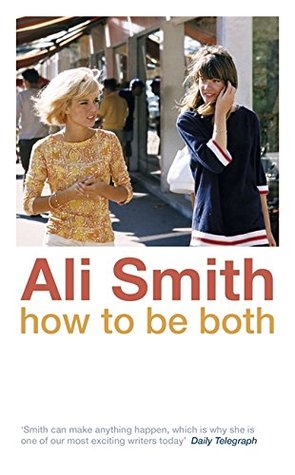
It’s not surprising that of the 2014 Goldsmiths Prize contenders, How to Be Both took the crown. The novel is multidimensional. It is innovative, witty, dark, and thought provoking all at the same time. Smith has created a conceptual maze, where every time you think you’ve arrived at her purpose for writing, you’ll be presented with a new commentary on art, history, and perception and you’ll think: ah, so this is what she’s getting at.
Prior to the takeoff of her writing career, Ali Smith grew up in Scotland, attended the University of Aberdeen, and briefly pursued a PhD at Newnham College. After her studies, she landed jobs writing for The Guardian, The Scotsman, and The Times Literary Supplement. Smith has written several popular books on her own prior to her most recent, including The Accidental, There But For The, and an essay collection titled Artful. But with How to Be Both she does something ground breaking – publishes two editions of the book with the same cover, but with its two sections flipped.
One half of Smith’s readers will first learn the story of a simultaneously sardonic and sweet sixteen year old coping with the loss of her mother. The other half will first be captivated with a story of an Italian Renaissance painter. Either way, Smith’s audience will see the two stories delightfully interlace.
The copy I picked up at random began with a sixteen year old girl, George. After her mother dies, she is left to look after her brother, her unstable father, and to make sense of time and existence. In pondering how someone could all of a sudden cease to exist in a tangible presence, George constantly recounts the last trip she took with her mother. Accompanied by her younger brother, Henry, they traveled to Italy to visit the home of a painting by the Renaissance artist that the second section of the book follows. George’s mother had admired the painting for quite some time – its gender ambiguity, its statements about sexuality, and its juxtaposition of good and bad that seem to be ahead of its era.
Sitting outside at a restaurant, George’s mother commends the Italian setting for its history. George replies that she is “appalled by history,” that its only redeeming quality is that it “tends to be well and truly over.” Her mother responds with a series of inquiries that shape how we interpret the rest of the narrative—at least for those who read this section first. She asks George: “Do things just go away? … Do things that happened not exist, or stop existing, just because we can’t see them happening in front of us?” A few moments later, she half-answers her own query by telling her daughter that “nothing’s not connected.” After this dialogue, the story is held together by a series of connections between George, her mother’s past, and her mother’s favorite Renaissance figure.
Francesco del Cossa is the name of the revered artist. Francesco is born a female, but binds her chest and presents herself as a male from early adolescence on, so that she can be properly schooled and trained as a painter. She is appointed to create a paining that displays something other than a biblical figure—typical to her time. This is when she creates the painting that drove George’s mother’s curiosity, and by extension, George’s curiosity.
Francesco’s section of the novel begins, structurally, as if it were a selection from Ezra Pound’s later works—its words slide zigzag across the first few pages. It seems to be a reflective account of Francesco’s early life and work—her experiences sorting through identity while the rest of the world perceives her as a male. But as the story unfolds we discover that Francesco is stuck in a state of purgatory, where she recounts not only memories but visions of the future. One moment she is recalling her youth and the next it is 2013. Francesco is transported to the moment in time that George is so attached to. George and her mother gawk at Francesco’s Renaissance mural, while Francesco tries to identify George’s iPad, dubbing it the “holy votive tablet.”
There are many parallels between the two main characters. Francesco’s mother’s died before she reached adulthood, just as George’s did. Francesco masks herself as a male, while George has a gender neutral name, and is mistaken at first, by Francesco, as a boy. As the lives and dimensions of the two characters collide and intertwine, we are shown that everything is connected. Smith shows us that we can discover parts of ourselves in exploring the lives and work of those who have come before us. Those who are no longer here still shape the future. Everything is connected. History is always relevant and struggle is universal. Despite the five hundred year time difference, George and Francesco face the same burden of death and the discovery of self-identity.
How to Be Both is beautifully written in its lyrical language and the way that it defies convention. It is conceptually challenging, while still displaying a sense of humor. I would recommend the book to anyone seeking a clever blend of modern pop culture and the ever-so-relevant past.
Reviewed by: Micaela Donabella
